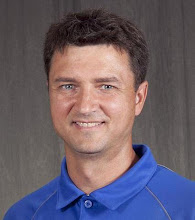
Have you ever noticed that really good players (5.0+) always have a forehand and backhand slice that they can use for returns, approaches, and touch shots? Sometimes it will even be confusing. You'll be watching an awesome player pound the ball around the court with powerful, heavy topspin shots and then all of a sudden, even though they've got plenty of time to load up and hit a big topspin forehand, they'll switch to an Eastern grip (like a volley) on their forehand and float a ball deep down the line. Why would they do that!
The answer: Control. Think of your topspin forehand (or backhand) as a club and your slice forehand as a scalpel. You beat your opponent up and knock him off balance with the club, but when you go in for the kill you use the scalpel. Control is sacrificed when you hit your topspin forehand because 1) you are swinging hard to generate pace and spin and 2) your swing is a lot longer and more complicated. To the contrary, your slice shot allows a lot of control because 1) there is a short backswing and you can push your shot toward the target and 2) you don't have to swing nearly as hard to get the same depth of shot.
So, when you are in need of accuracy, switch to your scalpel. Think about all of the times you've been in position to put the point away because your opponent was off the court, and all you had to do was put the ball onto the other side of the court. Because it was such a wide-open shot you took some pace off of your forehand topspin shot and missed!!! Maybe it went in the net, or didn't have enough angle, but you missed the opportunity to put away the point. And it was because your topspin club shot was not designed to be slowed down and used to pin-point placement. A better option would have been to hit your topspin shot with the same pace and margin of error as usual, but an even better option would have been to switch to your scalpel and win the point with precision.
You may worry about losing pace and argue, "If I slice a shot to put away a groundstroke rally, I may be giving my opponent enough time to catch it." A lack of pace does help your opponent in general, but the slice on the ball keeps it from bouncing high which gives your opponent less time to catch the ball. Furthermore, with improved accuracy you can go for an even more extreme angle. Of course, no one expects to put away a point from the baseline with a slice shot, and that is not what is being asserted here. But for shots inside the court where your opponent is way wide, the slice shot groundstroke is the right answer because of its ability to find angles safely.
A lack of pace is actually a virtue of the slice groundstroke when used to approach the net because it gives you more time to get to the right position. If you approach the net with your club (topspin shot) several bad things happen 1) the ball bounces higher giving your opponent more time and ability to hit an aggressive passing shot 2) the ball gets there quickly meaning you may not be covering the easy passing angle and 3) you have a higher chance of missing the shot completely (in the net or long) or positioning it poorly enough to give your opponent a chance to hit an easy pass. Use your scalpel on approaches. Be deliberate and guide the ball down the line and deep. Because you are taking your time and using your slice shot, you can aim for a precise location safely.
Another reason to use your slice groundstroke when approaching the net is that often the ball is low to the ground when you hit it. You have to hit a low ball to approach often because your opponent's shot is so short and weak that by the time you get to it, it's nearly on the ground. A topspin shot is difficult to hit off a low ball; it's just not suited for that because there is no clearance to brush from low to high up the back of the ball. It's so low percentage that you shouldn't ever try to hit it when you're close to the net (unless in a desperate spot). Whenever you have to hit a short, low ball, you should always be thinking scalpel.
"But, I'm not accurate with my scalpel," you may cry. You might understand the logic of why the slice groundstroke is the best shot to hit in many situations, but when you try to hit it, you miss, especially on your forehand side. But, that's because, like any other shot you have to PRACTICE hitting it. Think about how much time you spend during practice clubbing the ball around. Practice using your scalpel when the ball is low, when you are stretched wide, when you are approaching the net, and when you have an easy put away shot. Those are situations in a match when you should be using it anyway. Then throw in some repetitions using your slice from the baseline and for returns of serve. If you can practice using the scalpel half as much as you practice using the club, you'll find that you can pull it out of your bag of tools when you need it.

No comments:
Post a Comment